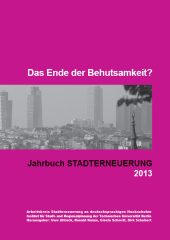„Schloss mit der Debatte!“? – Die Zwischennutzungen im Palast der Republik im Kontext der Schlossplatzdebatte

Format: 21,0 x 29,7 cm
Publishing year: 2008
On January 19, 2006, the German Parliament decided with an enormous majority to demolish the Palast der Republik (Palace of the Republic), a building of the former GDR located on the Schlossplatz (Palace Square) in the historical center of Berlin. Soon after this decision had been taken, the process of dismantling the building was begun. Earlier on, a similar majority had already decided to rebuild the Berliner Stadtschloss (Berlin City Palace), which stood on the same location for 500 years until it was demolished in 1950 by the GDR Government of Walter Ulbricht. What is hidden behind the clear majority relations is that these decisions were highly controversial for more than ten years following Germany’s reunification. Numerous experts judge the Palast der Republik to be a unique monument of historical value for Germany’s divided history. Furthermore, the Palast der Republik was turned into a popular and multi-functional event location between 2003 and 2005, as a consequence of which many concepts were developed for the building’s continued use. In addition to this, the financing of the Stadtschloss’ reconstruction was – and, to a certain extent, still is – not fully secured. This paper provides an overview of the several paradox developments in the history of the Palast der Republik, from its construction in the 1970s to its closure shortly before Germany’s reunification, which was followed by years of vacancy and asbestos abatement in the 1990s, to the temporary usage of the building from 2003 to 2005 and the beginning of its demolition in 2006. The text takes a critical look at the intense debate about the different options of construction on the Schlossplatz, the so called Schlossplatzdebatte (Palace Square debate), which began in the 1990s and lasted until the early 2000s. As a result of the very different temporary usages of the Palast der Republik, the debate was re-activated through different actors and issues in 2002. This paper focuses mainly on the influence the temporary usages had on the Schlossplatzdebatte. Particularly the actors of the popular event series ‘VOLKSPALAST’ were successful in exposing the debates of the past about urban design and aesthetical aspects of the Schlossplatz as insufficient. Through ‘VOLKSPALAST’ and other events, it became obvious that the often criticised bleakness of the Palast der Republik and the Schlossplatz resulted from their being unused. This resulted in a turnaround in the public opinion and the media in favour of the building’s preservation. However, the over ten years of vacancy had led to the creation of a successful coalition of supporters for the reconstruction of the Berliner Stadtschloss. This coalition achieved that the demolition of the Palast der Republik was enforced, although the financial and conceptual details for the reconstruction plans had not yet been completed. Due to the change in public opinion about the Palast der Republik, the supporters of the reconstruction were afraid that their project was in danger. In the end, contrary to their intention, the temporary usages of the Palast der Republik were too successful in the sense that the more success they had, the more quickly decisions were taken for the building’s demolition.



